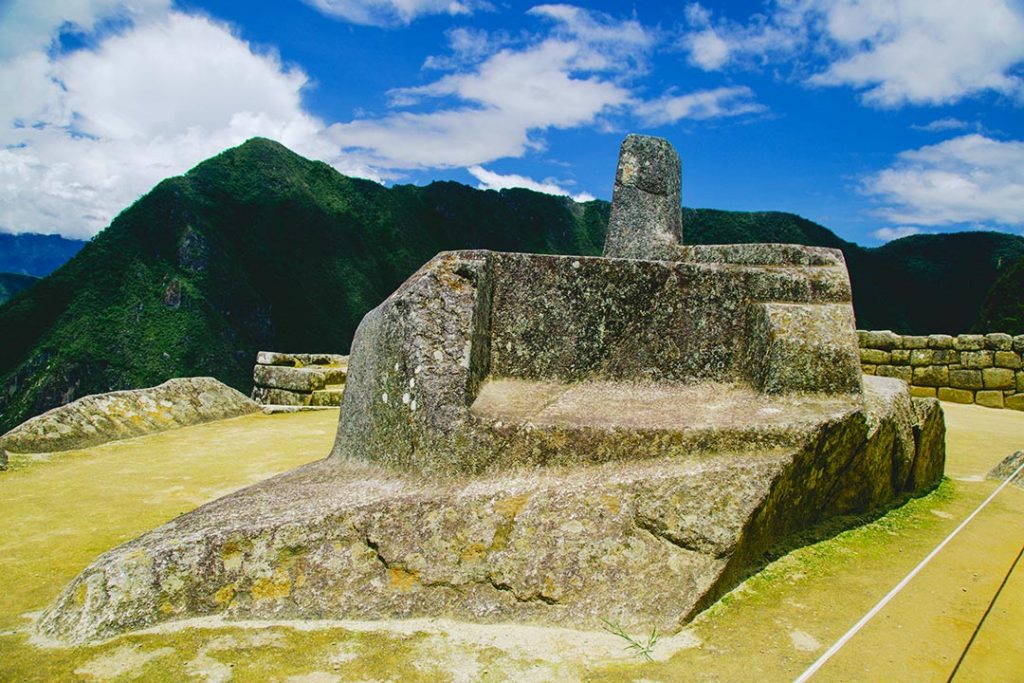Machu Picchu, one of the New Seven Wonders of the World, attracts thousands of visitors each year. The site astounds everyone who goes there with the incredible large stones strategically placed on a mountainside as well as the stunning surroundings.
One thing that stands out and perhaps gives us more hints to what the site was really used for is the intriguing Intihuatana stone. It’s the most visited site in Machu Picchu and you’ll definitely see it on your trip. A lot of people get told it’s just a sundial, but it was a lot more than that.
In this article, we’ll explore what the stone looks like and what its main function was. We’ll also tell you about another Intihuatana in Pisac and give you a few facts about the stone in Machu Picchu.
What Is the Intihuatana Stone?
The word Intihuatana is in the Quechua language, which was spoken by the Incas and still many people in Peru today. It means ‘place to tie up the sun’. Inti means sun, wata to tie, and na is a suffix to mean a tool or place. We aren’t sure that the Incas actually gave it this name as there are no written records, but experts named it this due to its form and function.
What Does the Intihuatana Stone Look Like?
The Intihuatana at Machu Picchu was carved from a huge slab of rock from the surrounding mountains. It stands at the highest elevation inside the archeological site, which is usually known as the Sacred Plaza. It sits above a pyramid-like tiered form with the rock on top.
It’s a four-sided stone and each point represents the north, south, east, and west. It does look like a sundial, which was one of its main purposes. You’ll also notice lots of other steps and dents on the stone, which indicate other uses of the Intihuatana.

How to Find the Intihuatana in Machu Picchu
If you visit Machu Picchu by yourself and need to locate the stone, you’ll find it in the Hanan part of the archeological site, which is near a hill in a pyramid shape. There are two sets of steps that lead directly to the Intihuatana. One comes from the north-side of the complex and the other from the south.
It is one of the major sites in Machu Picchu and shouldn’t be missed. You need to keep in mind that a lot of visitors will be heading to the stone and it is only open from 7-10 am, so make sure you visit in that period.
What Was the Intihuatana Stone’s Function?
Most experts agree that the Intihutana’s main function was astronomical. The idea that it was a sundial comes from the fact that the sun sits directly above the stone on the two equinoxes (March 21st and September 21st) and it creates no shadow at all. This happens because the point on the Intihuatana has a slight inclination of 13 degrees. This really shows the depth of knowledge the Incas had regarding astrology.
Many believe that the Incas performed ceremonies on these dates to ensure a great harvest and prosperity throughout their community. The sun god (Inti) was the main god of the ancient culture, and they held huge respect for the celestial body.
Sometimes the Intihuatana is associated with the summer and winter solstice, but this is likely untrue. The Temple of the Sun that’s just a few hundred meters away is the only place that casts a shadow on these dates. Inti Raymi is the winter solstice festival and is celebrated in Cusco on June 24th every year.
However, on the summer solstice in December, the light from the sunrise projects a triangle on the Intihuatana which shows two clear circles on the ground. No one is entirely sure of its use, but these are popular theories.
Regarding the small dents and steps, some suggest they were for astronomical purposes while others think they were likely used in ceremonies, maybe for sacrifices or putting mummies of their ancestors on.
One thought suggests that on the equinox dates the Inca would ‘tie’ the sun down to stop it from going down forever. They knew that if the sun didn’t exist, all life as they knew it would come to an end.
There’s one thing we know for sure, and that’s the fact that the Incas were an extremely agricultural society. Being so high up in the mountain also meant that sowing seeds at the right times of year would make crops flourish rather than die. For this reason, the speculations surrounding Intihuatana are very likely true.
Development of Knowledge About the Intihuatana at Machu Picchu
In 1920, by coincidence, a German astronomer called Ralf Müller figured out that the two larger sides of the stone were looking 25.5 degrees off magnetic north and 27.5 degrees off magnetic west. Because of this, he worked out that they would point in those directions at the start of winter and summer.
Before him and Hiram Bingham, no one in the western world knew about the stones at Machu Picchu. However, it’s thought that William Prescott wrote something about Intihuatana at Machu Picchu many years before in 1847, which says the following:
“The period of the equinoxes they determined by the help of a solitary pillar, or gnomon, placed in the center of a circle, which was described in the area of the great temple and traversed by a diameter that was drawn from east to west. When the shadows were scarcely visible under the noontide rays of the sun, they said that “the god sat with all his light upon the column.”
We aren’t entirely sure that this piece of text was about the Intihuatana as it was written 64 years before Hiram Bigham’s ‘rediscovery’ of the archeological site. There are also plenty of other cultures around the globe that celebrate similarly important celestial events. Many do believe it’s about the stone at Machu Picchu, though.
Another Example of an Intihuatana Stone
In addition to Machu Picchu, the Intihuatana stone in Pisac also survived. It’s around 85 km from the Inca citadel and often missed by tourists. A majority of visitors to Pisac only wander around the upper part of the archaeological site, but if you have the time, we recommend you head 30 minutes down into the valley to see the stone.
There’s actually a very well-maintained temple zone and in the middle, you’ll find a curved-wall structure, which indicates it was a temple of the sun. Inside this building is the small Intihuatana, only about 30 centimeters high.
Unlike the stone at Machu Picchu, this one was carved from the natural bedrock instead of being like a statue. Some say it was to form a link from the Earth to the spiritual world, which we know the Incas also had a great belief in.
Intihuatana Machu Picchu Facts
Here are a few fun facts we know about the Intihuatana stone at Machu Picchu.
- For many years, visitors were allowed to touch the stone to feel the energy that radiated off it. However, after some incidents, the sacred stone is now sectioned off. A security guard is always looking over the structure to make sure no hands are placed on the surface of the Intihuatana.
- A beer company was sued in 2005 for damaging the stone during a commercial they shot there. A 1,000-pound crane actually fell on the upper tip of the stone and, unfortunately, a small piece of it got chipped off. You can imagine the huge uproar from the locals.
- Many visitors still claim to feel huge energy or something special as they walk past the stone.
- As already mentioned, the stone can only be visited between 7-10 am every day.
Other Important Sites at Machu Picchu
If you’re wondering what other important parts of the Inca citadel you should visit, check out our list of must-see attractions in Machu Picchu.
- The Sun Gate (Inti Punku)
- Huayna Picchu
- Machu picchu Mountain
- Inca Bridge
- Watchman’s Hut
- The Funerary Stone
- Temple of the Sun
- Royal Tomb
- The Fountains
- Temple of Three Windows
- Principal Temple
- House of the High Priest
- House of Ornaments
- Central Plaza
- The Sacred Rock
- The Mortar/Industrial Section
- The Prison Group
- Terraces

Don’t Miss Out On Intihuatana
Despite the different theories as to what the stone was used for, the main belief is that it was for agricultural and astronomical purposes. When you visit Machu Picchu, make sure you head to Intihuatana to see its unique structure and see if you feel the energy so many have reported coming from the stone.
Written by: Liv Palmer













Leave A Reply